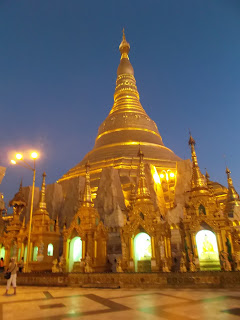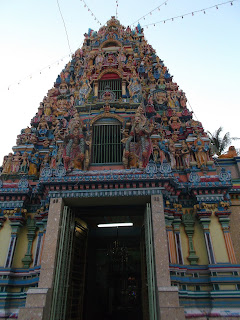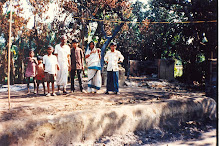Myanmar
(Burma) 2013:
Descendants
of Centuries-old Vibrant Burmese-Bengali Community
Sachi
G. Dastidar
February
2013
Burma, now called
Myanmar, and Bengal – Bangladesh, Tripura and West Bengal States of India – of
the Indian Subcontinent are neighbors to each other. For centuries people
migrated from each other, sharing food, culture, religion, economic
cooperation, and lastly British Colonial rule. Most Burmese are Buddhist
sharing with the religion of southeast Bengal, especially Chittagong area. Many
Burmese have migrated to what is today India and Bangladesh, among them the Mizo,
Moro, Chakma, Mogh and other tribes, many of whom are Buddhist, others
Christian or Hindu. Initially mostly Bengalis migrated to what is today’s
Myanmar, among them Bengali-Muslims who came to be known as Rohingiyas and
others Hindu who are called just Bengali, still others who are Buddhist. (Rohingiyas
are considered foreigners or illegal migrants and has no legal or citizenship
rights in Myanmar.) All three religious groups have married with locals
sometimes losing their linguistic or religious identity merging with the larger
Burmese community. Over two millenniums India and Burma shared their cultures,
as Buddhism that came from India and her script were influenced by India; while
her temple architecture were also influenced by Southern Indian and Sri Lankan
architecture. Since the arrival of the
British in Burma after King Thibaw’s defeat in 1885 at the Third Anglo-Burmese
War Burma became part of British Empire and India and Burma became one country
under British rule. Britain ruled the Southern Asia from its capital, first
from Calcutta, and then after 1912 from Delhi. Soon the largest of British
Indian province became Burma. Many Indian institutions became Burmese
institutions. During my visit a local Yangonite proudly mentioned that their
Yangon University was part of Calcutta University even after Burmese
independence in 1948. By 1885 when Britain took over Burma she had already
established her rule in India, including building of schools and colleges
graduating students with knowledge in English. Soon many Bengalis – Hindu and
Muslim – arrived, mostly from Burma’s neighbor Bengal, but also Tamils, Guajaratis,
Hindi-speakers, Telugus, Punjabis to take up jobs in the administration, being
technocrats, petty businessmen, and workers. Many of them were integrated in
Burmese socio-politics, but many also maintained their religious-cultural
sub-identity. However, Burma was separated from British-Indian administration
in 1937, but socio-economic relationship continued after Burma’s independence
in 1948. However, after a military dictatorship took over in 1962 many
“Indians” were expelled as they were considered “foreigners” and their
situation further deteriorated after 1964 when their businesses and assets were
nationalized for pennies. Incidentally after Britain took over India its last
emperor in the north, Bahadur Shah Zafar of Mughal Dynasty, was exiled in
Rangoon (renamed Yangon), the capital of Burma, whereas the last Burmese King
Thibaw was exiled in Bombay. Emperor Zafar, that of his wife and daughter’s
graves are in Yangon, and that of King Thibaw in Ratnagiri on the western coast
of India, near Mumbai (renamed Bombay.) Today a small yet vibrant
Burmese-Bengali and Burmese-Indian community exist in the large cities of
Yangon, Mandalay and a few others where they maintain their dual identity.
During my trip to Burma
in early 2013 I accidentally met up with many Burmese-Indian and
Burmese-Bengalis, mostly Hindu, and welcomed me to two of their landmark events
that were taking place: the 125th Anniversary Celebration of the
famous Sri Sri Durga Bari Mandir (Temple) in the heart of Yangon as well as the
Kalpa-Toru (Wish Fulfillment) Day Celebration of Ramakrishna Temple. At one
time there was a busy Ramakrishna Mission in Yangon with several Hindu monks
serving the large congregation. It also ran the Gandhi Hospital. But after the
army takeover the Mission and the hospital were taken over. Recently, after
political liberalization, the temple was returned back to the Hindu community,
but the Ramakrishna Order has decided not to return back. On every First
January of the Christian calendar the Ramakrishna Mission celebrates Kalpa-Toru
Day as Sri Ramakrishna had attended Christian churches (and Islamic and other
religious institutions) and celebrated many of the Christian holy days. The
present Ramakrishna Temple, multistoried building, there is a shrine for Lord
Buddha as well. At the Durga Bari Temple the priest, Mr. P. K. Chakraborty (or
Nihar), told me that there are about 300 Bengali-speaking Burmese Hindus in the
city; and several thousand other Burmese Hindus in the City. Priest Nihar
Chakraborty has been serving the temple for 46 years.
Here are a few pictures
from that trip.
The Golden Pagoda, Yangon
Bhagaban (Lord) Buddha
Sri Sri Durga Bari Temple of Goddess Durga
Invitation for the 125th Anniversary of Sri Sri Durga Temple in January of 2013
Inner Sanctum of Durga Temple with Priest P.K. (Nihar) Chakraborty
A Memorial Tablet at Durga Mandir
Kali Mandir Temple of the Black Goddess of Strength Kali
A Christian Church attracting both Myanmarese. Indian and other Nationalities
An Islamic Mosque attracting Indo-Burmese Devotees
The Last Mughal Ruler of West, Central, North and East India Bahadur Shah Zafar
Graves of King Zafar (L), his Wife and Daughter
Actual burial of King Zafar in the Basement, discovered Afterwards
Still-surviving Sign of the Old Ramakrishna Mission Library
Kalpa-Toru Celebration of January 1 of Ramakrishna Temple (on 3rd Floor)
Donor List of the Old Ramakrishna Mission of Rangoon
A New Donation Tablet for the Buddha Shrine in Ramakrishna Temple
Tablet for the Redevelopment of Ramakrishna Temple
Serving Bhog, the Blessed food, Lunch at Ramakrishna Temple
Writer Sarat Chandra Chattopadhyay's Old Neighborhood
The New Yangon
The Old Rangoon
The Old in New Myanmar























5 comments:
Yangon Durga Bari Head Pujari name is N.R.Chakraborty not P.K. Chakraborty, so pls take care for this...
Rangoon university was affiliated to
calcutta university before 1920.
In 1920 it become full-fledged and autonomous body.
The last Myanmar was taken and Permanently under house arrest in Ratnagiri not in Bombay .
Mind your history please!
The last King of Myanmar,Theebaw,was taken to Ratnagiri not in Bombay .
Post a Comment